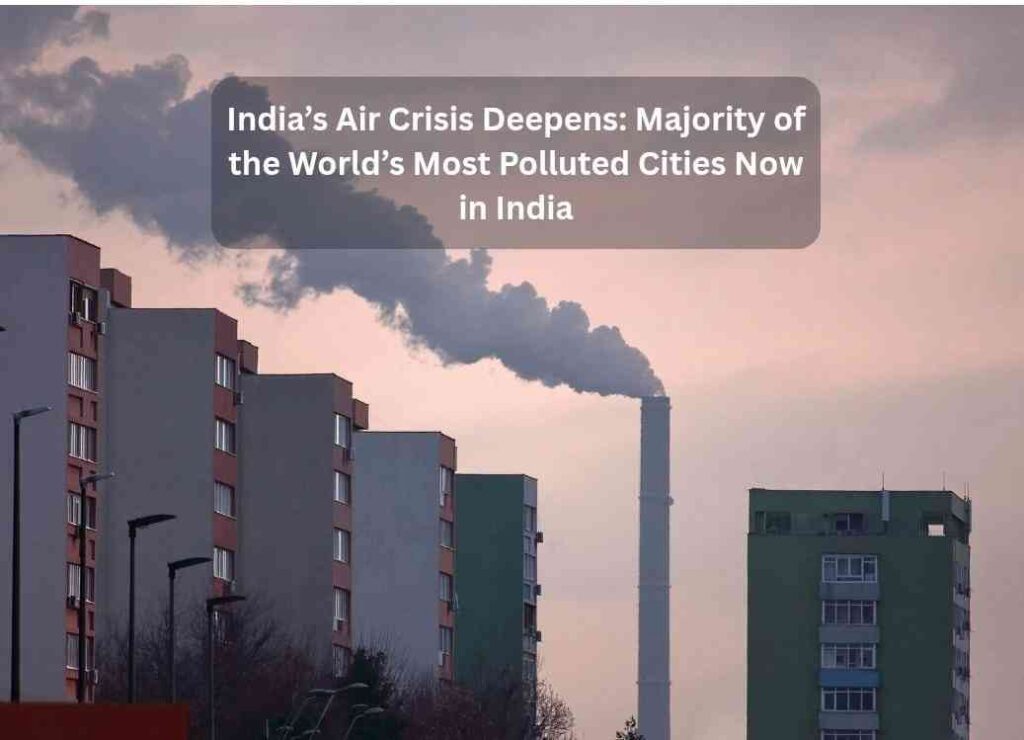India Once Again Tops Global Pollution Rankings — 70 of the World’s 75 Most Polluted Cities Are in India

India has, once again, found itself leading the world in an unfortunate statistic — air pollution. According to the latest Global Air Quality Report 2025 by AQI.in, 70 of the planet’s 75 most polluted cities are located within India. From megacities like Delhi, Lucknow, and Patna to smaller urban centers such as Siwani, Fatehabad, and Churu, the country’s skies have turned into a dense haze of smog, dust, and industrial fumes.
This alarming trend highlights a deep-rooted crisis that extends beyond city borders — one that affects millions of lives, the economy, and the very sustainability of India’s rapid growth story.
A Nation Under a Smog Blanket
As winter grips northern India, the familiar haze has returned — thick, gray, and almost tangible. The cooler temperatures and stagnant air trap pollutants close to the ground, transforming entire regions into gas chambers. The northern belt — especially the Indo-Gangetic plains — faces the worst of it, as agricultural residue burning in Punjab and Haryana mixes with emissions from vehicles, factories, and construction dust.
Major cities like Delhi have once again breached all safe air quality limits. In many neighborhoods, Air Quality Index (AQI) readings have crossed the ‘severe’ category, with values soaring above 450–500, levels considered dangerous even for healthy adults. For children, the elderly, and those with respiratory conditions, simply stepping outdoors has become a health hazard.
Residents wake up to the smell of smoke, burning eyes, and coughing fits. Flights are delayed, schools are closed, and the capital city wears an eerie gray veil — a grim reminder of how air pollution has become an annual public health emergency.
Why Is India’s Air So Polluted?
Experts say India’s pollution crisis is a result of multiple overlapping factors:
- Rapid Urbanization: Cities are expanding faster than infrastructure can keep up. Massive construction projects contribute tons of dust to the atmosphere every day.
- Vehicular Emissions: India adds millions of new vehicles to its roads each year, most running on fossil fuels. Traffic congestion and poor emission standards worsen the situation.
- Industrial Activity: From brick kilns to thermal power plants, industries release a steady stream of particulate matter and toxic gases.
- Crop Burning: After the harvest season, farmers in northern India often burn crop residues to clear fields, producing thick plumes of smoke that drift toward urban centers.
- Weather Conditions: During winter, lower wind speeds and temperature inversion trap pollutants near the surface, intensifying smog levels.
Despite efforts like the introduction of smog towers, odd-even vehicle rationing, and promotion of cleaner fuels, these are often temporary fixes. Experts stress that unless India adopts long-term sustainable policies — such as renewable energy transition, stricter industrial monitoring, and waste management reform — the air crisis will continue to worsen.
The Health and Economic Toll
Air pollution is not just an environmental issue — it’s a silent killer. According to medical studies, prolonged exposure to polluted air can lead to chronic respiratory diseases, heart problems, premature deaths, and cognitive decline in children.
The World Health Organization (WHO) estimates that millions of Indians die prematurely every year due to air pollution-related illnesses. Economically, it’s equally devastating — reduced productivity, increased healthcare costs, and absenteeism collectively cost the Indian economy billions of dollars annually.
Dr. Meera Kulkarni, an environmental health expert, explains:
“What we’re seeing now is not just bad air — it’s a systemic failure. The solution lies in rethinking our cities, our transport, and even how we grow food.”
The Road to Recovery — What Can Be Done
While the crisis seems overwhelming, experts and environmentalists agree that change is possible — but it must be urgent, coordinated, and consistent.
Key steps include:
- Stricter emission norms for industries and vehicles.
- Investment in electric mobility and efficient public transportation.
- Banning open waste burning and incentivizing sustainable farming practices.
- Mass urban tree planting drives to create natural carbon sinks.
- Public awareness campaigns that encourage citizens to take small but meaningful actions — from carpooling to reducing household waste.
India’s battle against pollution will not be won overnight. It requires collaboration between government, industry, and individuals — a national mission where clean air becomes a non-negotiable priority.
A Global Concern, Not Just India’s
The scale of India’s pollution crisis is such that it doesn’t stay confined within its borders. Winds carry particulate matter across countries, affecting neighboring regions and contributing to global climate change. The world cannot achieve its environmental targets if the air over South Asia continues to worsen.
As the planet races to curb greenhouse gas emissions and transition to cleaner energy, India’s situation serves as both a warning and an opportunity — to lead by example in tackling air pollution while sustaining economic growth.
Breathing clean air should not be a luxury reserved for a few — it is a basic human right. Unless decisive action is taken now, future generations will inherit a world where every breath comes at a cost.
India dominates global pollution rankings with 70 of the 75 most polluted cities.
Delhi, Lucknow, Siwani, and Churu are among the worst affected.
Pollution is driven by vehicular emissions, crop burning, industrial smoke, and urban dust.
Severe health impacts include rising asthma and lung disease cases.
Experts urge strong policy reforms and public participation for sustainable change.



